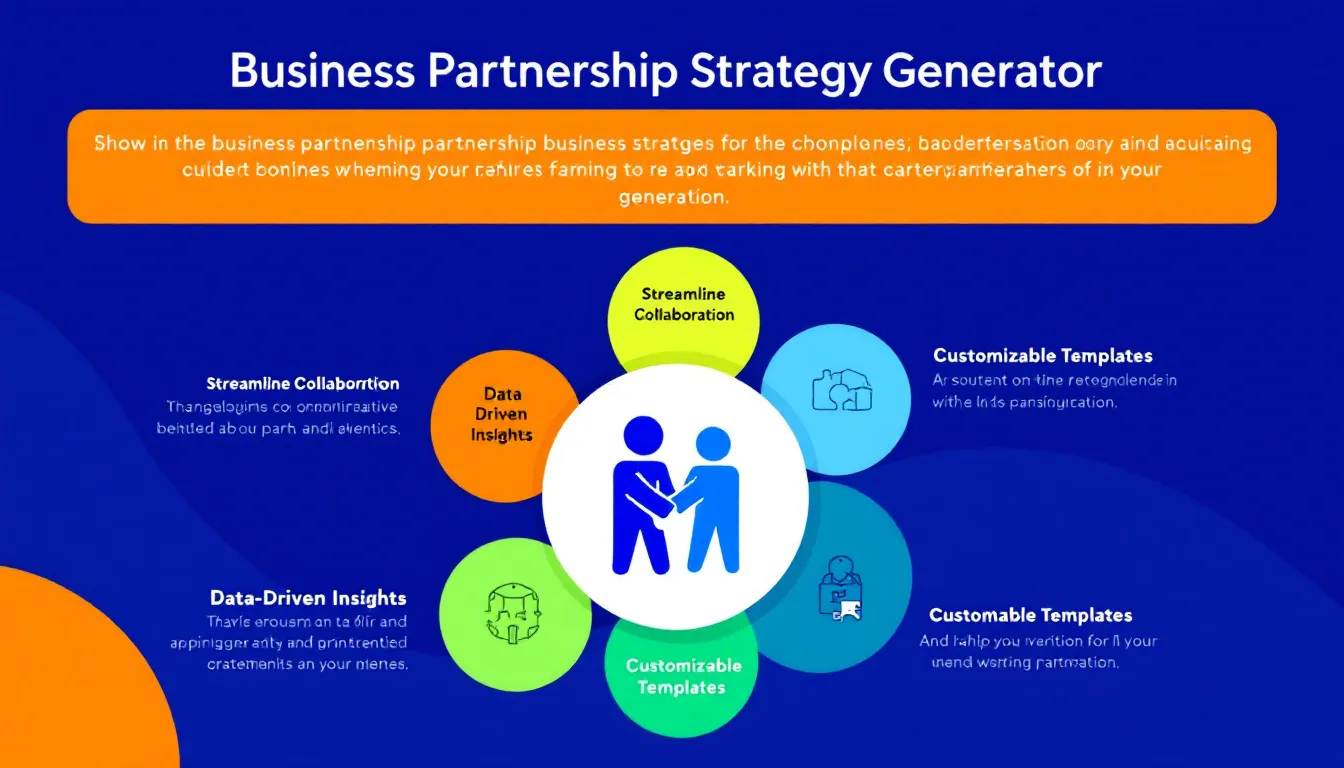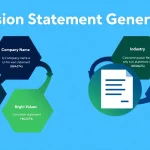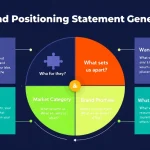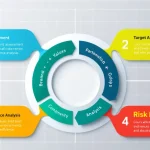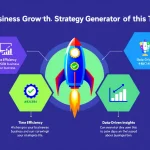Is this tool helpful?
How to Use the Business Partnership Strategy Generator Effectively
This tool helps you create tailored business partnership strategies based on your company’s profile and goals. Follow these steps to get actionable recommendations:
- Enter your business name: Fill in your company’s official name in the “Name of the business seeking partnerships” field. For example, you could use BrightWave Analytics or EcoNest Ventures.
- Specify your industry sector: Describe the main industry where your business operates. Examples include Financial Services or Organic Food Production.
- Select your business size: Choose the size category that fits your company. Typical options include Small (1-50 employees), Medium (51-250 employees), and Large (251+ employees).
- Detail your core values and mission (optional): Share your company’s guiding principles and purpose to help the tool suggest partners who align with your values. For instance: Innovation, Transparency, Community Wellness or Quality, Sustainability, Fair Trade.
- Define your partnership goals (optional): Describe what you want to achieve through partnerships. Example goals might be Expand into the Asia-Pacific market, launch eco-friendly product lines or Enhance technology integration, improve customer service experience.
- Generate your tailored strategies: Click the “Generate Partnership Strategies” button to receive customized, practical partnership recommendations based on your inputs.
Once you submit the information, the tool analyzes key factors about your business and partnership goals. It then delivers a set of strategies designed to help you identify, approach, and establish valuable business partnerships effectively. The recommendations will appear right below the form for easy review and implementation.
Introducing the Business Partnership Strategy Generator
The Business Partnership Strategy Generator is a practical tool created for business owners and managers to develop comprehensive partnership strategies. It focuses on helping you find suitable partners, improve outreach, and build lasting collaborations tailored to your unique business needs.
Purpose and Key Benefits
- Save time: Quickly generate partnership strategies without spending hours on research or consultations.
- Personalized recommendations: Get suggestions tailored to your industry, business size, core values, and partnership goals.
- Comprehensive strategy: Covers all partnership stages from identifying prospects to formalizing agreements.
- Ethical and sustainable: Ensures your partnership tactics align with professional and legal standards.
- Long-term success: Focuses on strategies that support sustainable growth and mutual benefits.
Practical Applications of the Business Partnership Strategy Generator
This tool fits diverse industries and business sizes, providing actionable partnership strategies customized for your specific context. Here are real-world use cases to understand how it supports your business goals:
1. Small Renewable Energy Firm Seeking Strategic Collaborations
Scenario: A startup focusing on solar panel innovations wants to partner with distribution companies to expand regional reach.
- Business Name: SunCore Technologies
- Industry: Renewable Energy
- Size: Small
- Core Values: Sustainability, Innovation, Reliability
- Partnership Goals: Expand distribution channels and develop joint marketing campaigns
Recommended strategies include:
- Connect with regional renewable energy trade associations to identify distribution partners.
- Attend green energy expos and networking events to build relationships with potential partners.
- Leverage digital platforms like LinkedIn to research and reach out to distribution companies.
- Prepare co-branded marketing materials highlighting shared values and sustainability focus.
- Establish clear partnership agreements emphasizing quality standards and customer service commitments.
2. Medium-sized Food Manufacturer Targeting Retail Partnerships
Scenario: A company producing organic snacks wants to collaborate with regional supermarket chains to increase product placement.
- Business Name: GreenFields Organics
- Industry: Organic Food Production
- Size: Medium
- Core Values: Health, Sustainability, Transparency
- Partnership Goals: Secure shelf space in major retail outlets and develop joint promotion campaigns
Suggested strategies include:
- Identify retail chains with a sustainability focus for targeted partnership proposals.
- Attend regional food and beverage trade fairs to meet retail buyers and category managers.
- Craft personalized outreach emails highlighting your organic certification and shared values.
- Explore co-marketing opportunities such as in-store demos and social media campaigns.
- Work with legal counsel to draft partnership agreements detailing supply terms and promotional commitments.
Understanding How This Tool Supports Your Business Growth
Comprehensive Partnership Strategy Development
This tool guides you through every stage of partnership development, including:
- Researching and identifying ideal partners that complement your business
- Assessing compatibility based on shared values, capabilities, and objectives
- Crafting initial outreach strategies tailored to the partner type
- Developing negotiation tactics that secure mutually beneficial agreements
- Formulating clear and ethical partnership contracts
Industry- and Size-Specific Recommendations
By entering your industry and business size, you receive realistic strategies that fit your market context and resources. This ensures your partnership efforts are targeted and achievable.
Value and Goal Alignment
Including your core values and partnership goals helps the tool suggest partners and tactics aligned with your business philosophy and intended outcomes. This alignment fosters stronger, long-lasting collaborations.
Balanced Online and Offline Strategy Mix
You get a mix of digital and traditional outreach methods, such as leveraging social networks and industry events. This blend maximizes your chances of connecting with the right partners effectively.
Ethical Partnership Focus
The tool emphasizes transparency, fairness, and compliance with legal regulations throughout the partnership development process. This approach safeguards your reputation and promotes mutually respectful relationships.
Continuous Improvement Through Reuse
You can use the tool multiple times with updated inputs to refine your strategies based on real-world feedback, helping you improve your partnership building over time.
Addressing Common Challenges in Business Partnership Development
1. Finding Suitable Partners
The tool offers tactics for researching partners using:
- Industry-specific databases and directories
- Professional networking platforms like LinkedIn for targeted partner searches
- Trade shows, conferences, and local business associations
2. Evaluating Compatibility
It guides you through assessing partners by:
- Comparing mission statements and core values
- Reviewing financial health and market reputation
- Analyzing cultural and operational fit
3. Crafting Effective Outreach
You receive ideas for making strong first impressions, such as:
- Writing personalized introduction emails
- Utilizing mutual contacts for warm introductions
- Preparing elevator pitches for events and meetings
4. Negotiating and Formalizing Agreements
The tool highlights negotiation tactics and key contract items, including:
- Clarifying partnership goals to guide discussions
- Striving for win-win solutions
- Including confidentiality, intellectual property, and termination clauses
- Knowing when to involve legal professionals
5. Maintaining Ethical Standards
It stresses the importance of ethical practices, such as:
- Being transparent and honest in communications
- Ensuring fairness and respecting partner interests
- Protecting confidential information and IP rights
- Following all applicable laws and industry regulations
Important Disclaimer
The calculations, results, and content provided by our tools are not guaranteed to be accurate, complete, or reliable. Users are responsible for verifying and interpreting the results. Our content and tools may contain errors, biases, or inconsistencies. Do not enter personal data, sensitive information, or personally identifiable information in our web forms or tools. Such data entry violates our terms of service and may result in unauthorized disclosure to third parties. We reserve the right to save inputs and outputs from our tools for the purposes of error debugging, bias identification, and performance improvement. External companies providing AI models used in our tools may also save and process data in accordance with their own policies. By using our tools, you consent to this data collection and processing. We reserve the right to limit the usage of our tools based on current usability factors.
